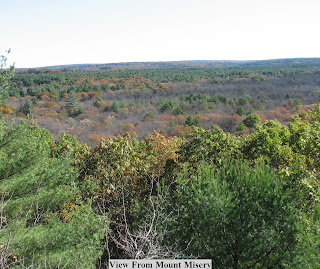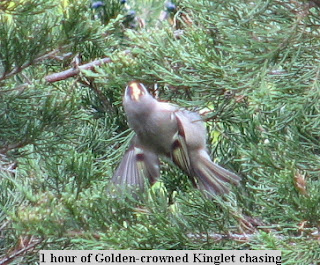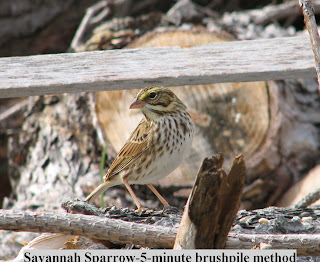 Over the years, Fall has been my favorite time to go camping. There are only three state campgrounds that stay open past mid October. I chose Mount Misery Campground in Voluntown, CT because it offers something that the others don't: solitude. It would have been nice if my wife, Joan, came with me. The idea of sleeping in a tent with overnight temperatures in the 20's didn't appeal to her, although she did a great job recording The Red Sox winning The World Series-GO SOX!
Over the years, Fall has been my favorite time to go camping. There are only three state campgrounds that stay open past mid October. I chose Mount Misery Campground in Voluntown, CT because it offers something that the others don't: solitude. It would have been nice if my wife, Joan, came with me. The idea of sleeping in a tent with overnight temperatures in the 20's didn't appeal to her, although she did a great job recording The Red Sox winning The World Series-GO SOX!Camping holds a special appeal to me. Spending time in a secluded forest tends to clear your mind from things that would normally distract you and helps you reconnect with nature. I prefer not to over prepare for a camping trip. Being without some of the modern conveniences that we have become so dependent upon forces you to rely on your own ingenuity to solve basic problems. For example, I discovered after my first night's stay that the ground was a little bit harder than I had anticipated. The next day, I stuffed leaves and fallen soft pine needles under the tent. It worked like a charm. Can you believe that I forgot to pack eating utensils? Not a problem. The ready to eat tuna & cracker snack pack I brought came with a spoon. Of course, it was small enough for a mouse to use. Well, they always say you should take your time eating meals-and I certainly did!
 On the day of my arrival, I followed a trail that took me to the top of Mount Misery. The view doesn't seem to fit the name. I believe that the name came from the fact that the soil in the area was so rocky that it made it very difficult for farming way back when. Old cellar holes and miles of stone walls throughout the woods is evidence that the entire forest was once a farming community. Mount Misery itself, has an elevation of only about 400 feet, so it doesn't really qualify as a mountain. It's a little steep going up but makes for a nice short hike.
On the day of my arrival, I followed a trail that took me to the top of Mount Misery. The view doesn't seem to fit the name. I believe that the name came from the fact that the soil in the area was so rocky that it made it very difficult for farming way back when. Old cellar holes and miles of stone walls throughout the woods is evidence that the entire forest was once a farming community. Mount Misery itself, has an elevation of only about 400 feet, so it doesn't really qualify as a mountain. It's a little steep going up but makes for a nice short hike. After my hike through the woods, I sat back in my chair and looked up admiring the view of the treetops set against the backdrop of a beautiful blue sky. It wasn't long after this picture was taken before darkness fell. Thousands of stars filled the night sky. Cygnus (the swan), also known as the Northern Cross, was directly overhead.
After my hike through the woods, I sat back in my chair and looked up admiring the view of the treetops set against the backdrop of a beautiful blue sky. It wasn't long after this picture was taken before darkness fell. Thousands of stars filled the night sky. Cygnus (the swan), also known as the Northern Cross, was directly overhead. This is a trail through a 26 acre Giant Rhododendron sanctuary. It has a short, packed gravel trail followed by a raised boardwalk that leads to a deck overlooking an Atlantic White Cedar Swamp. They say that visiting this site in late June or early July offers a breathtaking view of the blooming flowers.
This is a trail through a 26 acre Giant Rhododendron sanctuary. It has a short, packed gravel trail followed by a raised boardwalk that leads to a deck overlooking an Atlantic White Cedar Swamp. They say that visiting this site in late June or early July offers a breathtaking view of the blooming flowers. Here is the beginning of the swamp located just beyond the Rhododendrons. Another nice feature of this whole area is that it's wheelchair accessible.
Here is the beginning of the swamp located just beyond the Rhododendrons. Another nice feature of this whole area is that it's wheelchair accessible. The first birds that I saw along the trail were two Hermit Thrushes. They can be found in Connecticut sporadically throughout the winter. Another sighting was that of a juvenile Yellow-bellied Sapsucker. I thought it was a male because it was starting to show red on the top of its head. Later, after consulting my field guide, I realized that both male and female show some red on the crown. The next time I see a juvenile sapsucker, I'll have to study it a little more carefully. A Hairy Woodpecker was within twenty feet of the sapsucker. It was interesting to compare the size and features of the two species. I had another interesting experience here. Early in the morning, I heard a small flock of birds singing a distinct but unfamiliar song. It was a fairly short song but filled with many rapid notes. The birds were picking at pine cones at the top of some very tall coniferous trees. The view was too distant to make out any details and flew off after a few moments. I suspect that they may have been some sort of winter finch. I went back later, with a scope hoping to get a better look, but there was no sign of them. I feel as though I missed a good opportunity to see a new species. Oh well, that's the breaks!
The first birds that I saw along the trail were two Hermit Thrushes. They can be found in Connecticut sporadically throughout the winter. Another sighting was that of a juvenile Yellow-bellied Sapsucker. I thought it was a male because it was starting to show red on the top of its head. Later, after consulting my field guide, I realized that both male and female show some red on the crown. The next time I see a juvenile sapsucker, I'll have to study it a little more carefully. A Hairy Woodpecker was within twenty feet of the sapsucker. It was interesting to compare the size and features of the two species. I had another interesting experience here. Early in the morning, I heard a small flock of birds singing a distinct but unfamiliar song. It was a fairly short song but filled with many rapid notes. The birds were picking at pine cones at the top of some very tall coniferous trees. The view was too distant to make out any details and flew off after a few moments. I suspect that they may have been some sort of winter finch. I went back later, with a scope hoping to get a better look, but there was no sign of them. I feel as though I missed a good opportunity to see a new species. Oh well, that's the breaks! Some of the other birds I saw during my stay included: Northern Cardinal, Eastern Bluebirds, Golden-crowned Kinglets, Ruby-crowned Kinglets, Yellow-rumped Warblers, White-throated Sparrows, 5 Brown Creepers, and 6 Red-breasted Nuthatches. The most numerous species of birds were American Robins and Dark-eyed Juncos. I saw hundreds of each. Oh yeah... I almost forgot! I found 8 Rusty Blackbirds feeding on the grass in the picnic area. That was a new species for me. I had to look at them for a while before figuring out what they were. They have a pale iris but a shorter tail than a grackle.
Some of the other birds I saw during my stay included: Northern Cardinal, Eastern Bluebirds, Golden-crowned Kinglets, Ruby-crowned Kinglets, Yellow-rumped Warblers, White-throated Sparrows, 5 Brown Creepers, and 6 Red-breasted Nuthatches. The most numerous species of birds were American Robins and Dark-eyed Juncos. I saw hundreds of each. Oh yeah... I almost forgot! I found 8 Rusty Blackbirds feeding on the grass in the picnic area. That was a new species for me. I had to look at them for a while before figuring out what they were. They have a pale iris but a shorter tail than a grackle.I drove down one of the many dirt roads to collect some of the fallen limbs for firewood. Some of the roads through this 24,000 acre forest seem to go on forever. It amazed me that there were picnic tables miles out in the middle of nowhere. The woods had a dark and eerie feel to them. I can see how the ghostly legends surrounding Pachaug Forest got started. Your imagination can get the best of you when you're all alone in the woods.
I sat by the fire on the eve before my departure. I could hear the strange, but wonderful, vocalizations of the Barred Owl echoing through the night. The fire was slowly dwindling down and I had used up the last of the firewood. I played a few bars on my harmonica as I listened to the final words of a Dylan song: Strike another match, go start anew -And it's all over now, Baby Blue...









 I only spent about 20 minutes in this field and then headed back out on the road again. Thanks to the owners, whoever they are.
I only spent about 20 minutes in this field and then headed back out on the road again. Thanks to the owners, whoever they are. By the time I reached The Wildlife Management Area, my level of enthusiasm had diminished just a little. I'm always fascinated by swamp habitat and I enjoyed getting a view of the area. There was a burst of bird activity just as I neared the swamp area that included: White-throated Sparrows,Black-capped Chickadees,Ruby-crowned Kinglets, Woodpeckers-(RB,NF,Hairy& Downy),and an Eastern Towhee. I took a quick tour around the swamp, but the rest of the area was not as productive.
By the time I reached The Wildlife Management Area, my level of enthusiasm had diminished just a little. I'm always fascinated by swamp habitat and I enjoyed getting a view of the area. There was a burst of bird activity just as I neared the swamp area that included: White-throated Sparrows,Black-capped Chickadees,Ruby-crowned Kinglets, Woodpeckers-(RB,NF,Hairy& Downy),and an Eastern Towhee. I took a quick tour around the swamp, but the rest of the area was not as productive. 

 A few of the other birds we saw included Peregrine Falcon, Tree Swallows, Black Vulture, Sharp-shinned Hawk, Red-tailed Hawk, Cedar Waxwings, Palm Warbler, and Yellow-rumped Warblers.
A few of the other birds we saw included Peregrine Falcon, Tree Swallows, Black Vulture, Sharp-shinned Hawk, Red-tailed Hawk, Cedar Waxwings, Palm Warbler, and Yellow-rumped Warblers.





 I came across a few new fall birds along the CT. River. I counted 8
I came across a few new fall birds along the CT. River. I counted 8 
 I took a break along the way at a Japanese Garden.I really wasn't sure what that is, but I was curious enough to stop in. It was a small but peaceful area with lots of evergreens, a man-made stream, special huts, and rocks. I talked to the owner who told me that the huts were tied together with special Japanese knots that supposedly never come apart.Unfortunately, someone put Bass in his water which will eventually eat all his Koi Fish. Next time, I'll bring some tea or shade-grown coffee.
I took a break along the way at a Japanese Garden.I really wasn't sure what that is, but I was curious enough to stop in. It was a small but peaceful area with lots of evergreens, a man-made stream, special huts, and rocks. I talked to the owner who told me that the huts were tied together with special Japanese knots that supposedly never come apart.Unfortunately, someone put Bass in his water which will eventually eat all his Koi Fish. Next time, I'll bring some tea or shade-grown coffee.